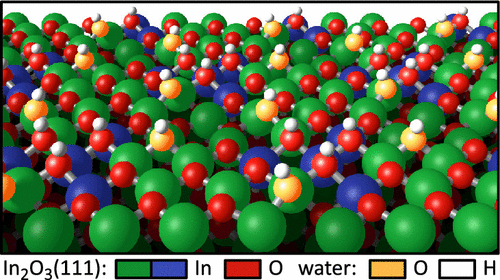Our official English website, www.x-mol.net, welcomes your
feedback! (Note: you will need to create a separate account there.)
Resolving the Structure of a Well-Ordered Hydroxyl Overlayer on In2O3(111): Nanomanipulation and Theory
ACS Nano ( IF 15.8 ) Pub Date : 2017-11-08 00:00:00 , DOI: 10.1021/acsnano.7b06387 Margareta Wagner 1 , Peter Lackner 1 , Steffen Seiler 2 , Achim Brunsch 2 , Roland Bliem 1 , Stefan Gerhold 1 , Zhiming Wang 1 , Jacek Osiecki 3 , Karina Schulte 3 , Lynn A. Boatner 4 , Michael Schmid 1 , Bernd Meyer 2 , Ulrike Diebold 1
ACS Nano ( IF 15.8 ) Pub Date : 2017-11-08 00:00:00 , DOI: 10.1021/acsnano.7b06387 Margareta Wagner 1 , Peter Lackner 1 , Steffen Seiler 2 , Achim Brunsch 2 , Roland Bliem 1 , Stefan Gerhold 1 , Zhiming Wang 1 , Jacek Osiecki 3 , Karina Schulte 3 , Lynn A. Boatner 4 , Michael Schmid 1 , Bernd Meyer 2 , Ulrike Diebold 1
Affiliation

|
Changes in chemical and physical properties resulting from water adsorption play an important role in the characterization and performance of device-relevant materials. Studies of model oxides with well-characterized surfaces can provide detailed information that is vital for a general understanding of water–oxide interactions. In this work, we study single crystals of indium oxide, the prototypical transparent contact material that is heavily used in a wide range of applications and most prominently in optoelectronic technologies. Water adsorbs dissociatively already at temperatures as low as 100 K, as confirmed by scanning tunneling microscopy (STM), photoelectron spectroscopy, and density functional theory. This dissociation takes place on lattice sites of the defect-free surface. While the In2O3(111)-(1 × 1) surface offers four types of surface oxygen atoms (12 atoms per unit cell in total), water dissociation happens exclusively at one of them together with a neighboring pair of 5-fold coordinated In atoms. These O–In groups are symmetrically arranged around the 6-fold coordinated In atoms at the surface. At room temperature, the In2O3(111) surface thus saturates at three dissociated water molecules per unit cell, leading to a well-ordered hydroxylated surface with (1 × 1) symmetry, where the three water OWH groups plus the surface OSH groups are imaged together as one bright triangle in STM. Manipulations with the STM tip by means of voltage pulses preferentially remove the H atom of one surface OSH group per triangle. The change in contrast due to strong local band bending provides insights into the internal structure of these bright triangles. The experimental results are further confirmed by quantitative simulations of the STM image corrugation.
中文翻译:

解决In 2 O 3(111)上排列整齐的羟基覆盖层的结构:纳米操纵和理论
由水吸附引起的化学和物理性质的变化在与器件相关的材料的表征和性能中起着重要作用。具有良好表面特征的模型氧化物的研究可以提供详细的信息,这对于全面了解水与氧化物的相互作用至关重要。在这项工作中,我们研究了氧化铟单晶,氧化铟单晶是典型的透明接触材料,广泛用于各种应用中,并且在光电技术中最为突出。正如扫描隧道显微镜(STM),光电子能谱和密度泛函理论所证实的,在低至100 K的温度下,水就已经解离吸附。这种解离发生在无缺陷表面的晶格位置上。而在2 O3(111)-(1×1)表面提供了四种类型的表面氧原子(每单位晶胞总共12个原子),水离解仅在其中一个原子上发生,并与相邻的一对5倍配位的In原子一起发生。这些O-In基团围绕表面的6倍配位In原子对称排列。因此,在室温下,In 2 O 3(111)表面在每个晶胞中三个解离的水分子处饱和,从而导致具有(1×1)对称性的有序羟基化表面,其中三个O W H基团与在STM中,表面O S H基团一起成像为一个明亮的三角形。通过电压脉冲使用STM尖端进行操作优先去除一个表面O的H原子每个三角形S H组。由于强烈的局部频带弯曲而引起的对比度变化提供了对这些明亮三角形内部结构的洞察力。通过STM图像波纹的定量模拟进一步证实了实验结果。
更新日期:2017-11-08
中文翻译:

解决In 2 O 3(111)上排列整齐的羟基覆盖层的结构:纳米操纵和理论
由水吸附引起的化学和物理性质的变化在与器件相关的材料的表征和性能中起着重要作用。具有良好表面特征的模型氧化物的研究可以提供详细的信息,这对于全面了解水与氧化物的相互作用至关重要。在这项工作中,我们研究了氧化铟单晶,氧化铟单晶是典型的透明接触材料,广泛用于各种应用中,并且在光电技术中最为突出。正如扫描隧道显微镜(STM),光电子能谱和密度泛函理论所证实的,在低至100 K的温度下,水就已经解离吸附。这种解离发生在无缺陷表面的晶格位置上。而在2 O3(111)-(1×1)表面提供了四种类型的表面氧原子(每单位晶胞总共12个原子),水离解仅在其中一个原子上发生,并与相邻的一对5倍配位的In原子一起发生。这些O-In基团围绕表面的6倍配位In原子对称排列。因此,在室温下,In 2 O 3(111)表面在每个晶胞中三个解离的水分子处饱和,从而导致具有(1×1)对称性的有序羟基化表面,其中三个O W H基团与在STM中,表面O S H基团一起成像为一个明亮的三角形。通过电压脉冲使用STM尖端进行操作优先去除一个表面O的H原子每个三角形S H组。由于强烈的局部频带弯曲而引起的对比度变化提供了对这些明亮三角形内部结构的洞察力。通过STM图像波纹的定量模拟进一步证实了实验结果。











































 京公网安备 11010802027423号
京公网安备 11010802027423号